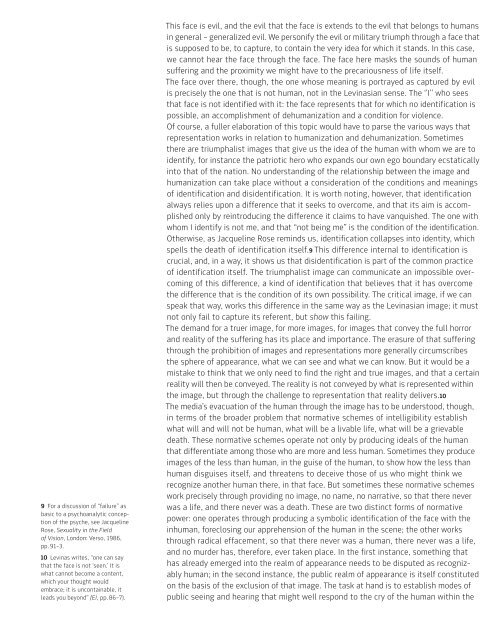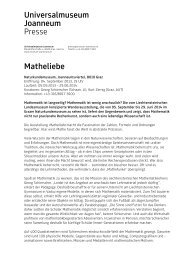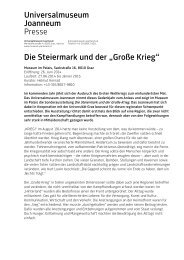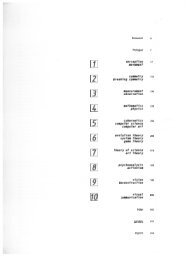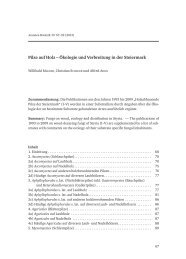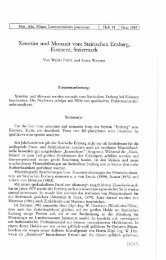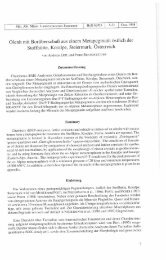Human Condition - Universalmuseum Joanneum
Human Condition - Universalmuseum Joanneum
Human Condition - Universalmuseum Joanneum
Erfolgreiche ePaper selbst erstellen
Machen Sie aus Ihren PDF Publikationen ein blätterbares Flipbook mit unserer einzigartigen Google optimierten e-Paper Software.
9 For a discussion of “failure” as<br />
basic to a psychoanalytic conception<br />
of the psyche, see Jacqueline<br />
Rose, Sexuality in the Field<br />
of Vision, London: Verso, 1986,<br />
pp. 91–3.<br />
10 Levinas writes, “one can say<br />
that the face is not ‘seen.’ It is<br />
what cannot become a content,<br />
which your thought would<br />
embrace; it is uncontainable, it<br />
leads you beyond” (EI, pp. 86–7).<br />
This face is evil, and the evil that the face is extends to the evil that belongs to humans<br />
in general – generalized evil. We personify the evil or military triumph through a face that<br />
is supposed to be, to capture, to contain the very idea for which it stands. In this case,<br />
we cannot hear the face through the face. The face here masks the sounds of human<br />
suffering and the proximity we might have to the precariousness of life itself.<br />
The face over there, though, the one whose meaning is portrayed as captured by evil<br />
is precisely the one that is not human, not in the Levinasian sense. The ‘’I’’ who sees<br />
that face is not identified with it: the face represents that for which no identification is<br />
possible, an accomplishment of dehumanization and a condition for violence.<br />
Of course, a fuller elaboration of this topic would have to parse the various ways that<br />
representation works in relation to human ization and dehumanization. Sometimes<br />
there are triumphalist images that give us the idea of the human with whom we are to<br />
identify, for instance the patriotic hero who expands our own ego boundary ecstatically<br />
into that of the nation. No understanding of the relation ship between the image and<br />
humanization can take place without a consideration of the conditions and meanings<br />
of identification and disidentification. It is worth noting, however, that identification<br />
always relies upon a difference that it seeks to overcome, and that its aim is accomplished<br />
only by reintroducing the difference it claims to have vanquished. The one with<br />
whom I identify is not me, and that “not being me” is the condition of the identification.<br />
Otherwise, as Jacqueline Rose reminds us, identification collapses into identity, which<br />
speIls the death of identification itself.9 This difference internal to identification is<br />
crucial, and, in a way, it shows us that disidentification is part of the common practice<br />
of identification itself. The triumphalist image can communicate an impossible overcoming<br />
of this difference, a kind of identification that believes that it has overcome<br />
the difference that is the condition of its own possibility. The critical image, if we can<br />
speak that way, works this difference in the same way as the Levinasian image; it must<br />
not only fail to capture its referent, but show this failing.<br />
The demand for a truer image, for more images, for images that convey the full horror<br />
and reality of the suffering has its place and importance. The erasure of that suffering<br />
through the prohibition of images and representations more generally circumscribes<br />
the sphere of appearance, what we can see and what we can know. But it would be a<br />
mistake to think that we only need to find the right and true images, and that a certain<br />
reality will then be conveyed. The reality is not conveyed by what is represented within<br />
the image, but through the challenge to representation that reality delivers.10<br />
The media’s evacuation of the human through the image has to be understood, though,<br />
in terms of the broader problem that normative schemes of intelligibility establish<br />
what will and will not be human, what will be a livable life, what will be a grievable<br />
death. These normative schemes operate not only by producing ideals of the human<br />
that differentiate among those who are more and less human. Sometimes they produce<br />
images of the less than human, in the guise of the human, to show how the less than<br />
human disguises itself, and threatens to deceive those of us who might think we<br />
recognize another human there, in that face. But sometimes these normative schemes<br />
work precisely through providing no image, no name, no narrative, so that there never<br />
was a life, and there never was a death. These are two distinct forms of normative<br />
power: one operates through producing a symbolic identification of the face with the<br />
inhuman, foreclosing our apprehension of the human in the scene; the other works<br />
through radical effacement, so that there never was a human, there never was a life,<br />
and no murder has, therefore, ever taken place. In the first instance, something that<br />
has already emerged into the realm of appearance needs to be disputed as recognizably<br />
human; in the second instance, the public realm of appearance is itself constituted<br />
on the basis of the exclusion of that image. The task at hand is to establish modes of<br />
public seeing and hearing that might weIl respond to the cry of the human within the


